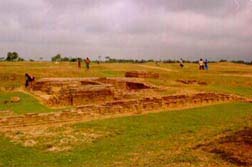Raja Karna's Palace

Information on Raja Karna's Palace (Murshidabad, West Bengal) - History & Architecture
Raja Karna's palace is popularly known as Rajbaridanga, which is situated in Murshidabad district of West Bengal. It is a ruined palace where only certain remains are left. Moreover, it is also a popular historical place, first exhumed by the archaeologists of Calcutta University in the year 1962.
Raja Karna's Palace Architecture
According to the excavation undertaken by the archaeologists, it has been found that the natural soil of Raja Karna's palace is composed of Gangetic incision which was discovered at a usual depth of 3 meter underneath the surface. The palace comprise a wall, having 13 passages of brick. In the midpoint of southern section of Raja Karna's palace, this wall formed a corner and turned toward east-west direction up to a length of 35 meter. In the eastern side, this wall is missing and in its place there is presence of massive wreckage of brickbats. The most fascinating architecture uncovered in Raja Karna's palace is the remnants of an additional wall, running in east-west way and having about 29 passages of bricks, ongoing at a stretch. This wall continued towards the main wall of the palace. Intense digging in the western area of Raja Karna's palace discovered the basis of initial platform on which the palace was constructed. This platform comprise large and well-burnt complete bricks. The excavation also discovered fragments of jars, sprinkles, cowries and iron objects among others which were supposed to be used by the royal family members.
The archaeological site of Raja Karna's palace exposed impeccable records relating to the identification of memorable 'Raktamrittika'. Sum up constructions activities have also been revealed from Raja Karna's palace. Structural leftovers comprising constant patterns and structures are clear from every trenches of Raja Karna's palace. Although no comprehensive architectural design for the building complex have been obtained from Raja Karna's palace, the type and character of the structural remains indicate the existence of Buddhist architecture. Its historical importance is well depicted by the beauty of the wall, architecture and the artifacts found here during excavation.
Raja Karna's Palace History
According to history, king Shashanka ruled over the palace is during 7th century. After the demise of Shashanka, Jayaskandhavara become the ruler of the place for a short period of time. The palace which is situated in Karnasubrana was supposed to the capital of Anga territory and presently only its ruins are existed. Legend also states that Anga was the empire of the prince of Kaurav namely Duryodhana and he bestowed the authority of the territory to the generous king Karna. According to Hindu epic which is described in Mahabharata, Karna is one of the key characters from ancient India. This palace was established according to his name. He was renewed as one of the utmost warriors of ancient time whose abilities, powers and skills are documented in Mahabharata.
Raja Karna's Palace Tourism Importance
Raja Karna's palace is a key specimen of ancient history of India. Although most part of the palace was damaged, the leftovers are still worth visiting. All the antiques which are gathered through excavation of the palace are restored in museum and have significant importance for people of historical interests. Furthermore, certain important parts of the palace are also excavated which makes it an important tourism place. It is the must visit historical monument in Murshidabad district, which illustrate the history to the visitors, which once was glorified with time.
- Andaman Nicobar Monuments
- Andhra Pradesh Monuments
- Assam Monuments
- Bihar Monuments
- Chhattisgarh Monuments
- New Delhi Monuments
- Goa Monuments
- Gujarat Monuments
- Haryana Monuments
- Himachal Pradesh Monuments
- Jammu and Kashmir Monuments
- Karnataka Monuments
- Kerala Monuments
- Madhya Pradesh Monuments
- Maharashtra Monuments
- Odisha Monuments
- Punjab Monuments
- Rajasthan Monuments
- Tamil Nadu Monuments
- Telangana Monuments
- Uttar Pradesh Monuments
- West Bengal Monuments